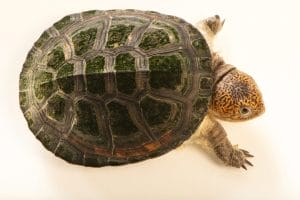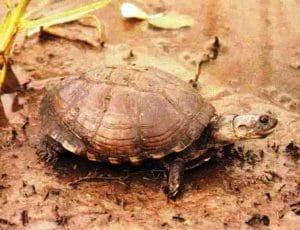Pelusios cupulatta (Ivory Coast mud turtle)
Home > Turtle Database > Pelusios cupulatta (Ivory Coast mud turtle)

Pelusios cupulatta is a freshwater turtle species native to West Africa. It’s one of the largest in its genus and is known for its dark, dome-shaped shell and secretive lifestyle.
Native To These Regions
Ivory CoastNative Turtle Species Map – Find Turtles by Region
Scientific Classification
Kingdom: Animalia
Phylum: Chordata
Class: Reptilia
Order: Testudines
Family: Pelomedusidae
Genus: Pelusios
Species: Pelusios cupulatta
Common Names
Ivory Coast mud turtle
West African black mud turtle
This Hilarious Turtle Book Might Know Your Pet Better Than You Do
Let’s be real—most turtle care guides feel like reading a textbook written by a sleep-deprived zookeeper.
This one’s not that.
Told from the snarky point of view of a grumpy, judgmental turtle, 21 Turtle Truths You’ll Never Read in a Care Guide is packed with sarcasm, sass, and surprisingly useful insights.
And hey—you don’t have to commit to the whole thing just yet.
Grab 2 free truths from the ebook and get a taste of what your turtle really thinks about your setup, your food choices, and that weird plastic palm tree.
It’s funny, it’s honest, and if you’ve ever owned a turtle who glares at you like you’re the problem—you’ll feel seen.
Identification
Description
This turtle has a dark brown to black carapace, often smooth and oval-shaped. The plastron is large and hinged, helping it close tightly when threatened. Adults can grow up to 30 cm in shell length, making it the biggest Pelusios species.
Sexual Dimorphism
Females are generally larger than males. Males usually have longer tails and slightly concave plastrons.
Check more turtles from the Pelusios genus
Native Origin and Distribution
Geographical Range
Found mainly in Ivory Coast and parts of southern Guinea. Its range is very limited and fragmented.
Preferred Habitat
It lives in slow-moving freshwater systems like swamps, marshes, forested rivers, and ponds. It prefers areas with soft bottoms and lots of cover.
Behavior
Feeding Habits
Pelusios cupulatta is an opportunistic feeder. It eats insects, worms, fish, snails, and sometimes plants or carrion.
Predators
Natural predators include large birds, crocodiles, and humans. Eggs and hatchlings are especially vulnerable.
Reproduction
Breeding Season
Breeding typically occurs during the rainy season.
Reproductive Method
It is oviparous. Females lay several eggs in shallow nests near water. Hatchlings emerge after a few months.
Conservation
Extinction Status
Not Evaluated
Threats
Habitat destruction, especially from agriculture and deforestation, is the biggest threat. Overcollection for the pet trade and local consumption also pose dangers.
Conservation Measures
Some protected areas cover parts of its range. More research, habitat protection, and law enforcement are needed to prevent extinction.
Economic Importance
It may be locally traded for food or traditional medicine. Occasionally appears in the exotic pet trade due to its size and rarity.
Interesting Facts
It’s the largest species in the Pelusios genus.
It can completely close its shell using a hinged plastron, giving it extra protection.
It’s rarely seen in the wild due to its secretive nature.

About Author
Muntaseer Rahman started keeping pet turtles back in 2013. He also owns the largest Turtle & Tortoise Facebook community in Bangladesh. These days he is mostly active on Facebook.














